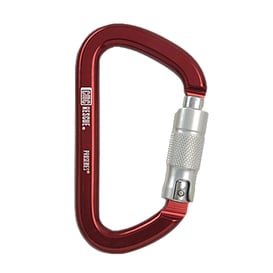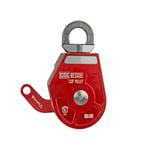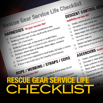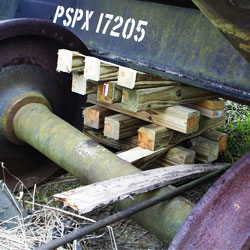 Depending on the manufacturer, you will find varying specifications for the service life of rescue equipment. For example, Petzl specifically defines the “potential” service life of plastic or textile products to be no longer than 10 years. It states "indefinite" for metallic products. CMC, on the other hand, does not give specified times for their equipment stating, “The service life of equipment used for rescue depends greatly on the type of use and the environment of use. Because these factors vary greatly, a precise service life of the equipment cannot be provided.” However, in reference to harnesses, CMC cites ASTM F1740-96 as the industry standard for service life. SMC follows along the lines of CMC when stating the amount of time a product can stay in service.
Depending on the manufacturer, you will find varying specifications for the service life of rescue equipment. For example, Petzl specifically defines the “potential” service life of plastic or textile products to be no longer than 10 years. It states "indefinite" for metallic products. CMC, on the other hand, does not give specified times for their equipment stating, “The service life of equipment used for rescue depends greatly on the type of use and the environment of use. Because these factors vary greatly, a precise service life of the equipment cannot be provided.” However, in reference to harnesses, CMC cites ASTM F1740-96 as the industry standard for service life. SMC follows along the lines of CMC when stating the amount of time a product can stay in service.
Although the definition of “equipment lifespan” is very broad depending on the manufacturer, each will provide specific instructions on proper inspection of equipment and detailed explanations on when to retire the item.
Most manufacturers follow the same general guidelines for removing equipment from service. Several general identifiers that pertain to all equipment are shown below.
REASONS FOR EQUIPMENT RETIREMENT INCLUDE:

- Item fails to pass any pre/post use or competent person inspection.
- Item has been subjected to a major fall or load.
- Item is constructed of plastic or textile material and is older than 10 years.
- You cannot determine the complete full-use history of item.
- You are not certain or have lost confidence in the equipment.
Most manufacturers will provide service for equipment items that are repairable. However, most caution against this because the cost of repair typically exceeds the cost of replacement. Any repairs attempted outside of the manufacturer may void any warranty and will release the manufacturer from any liability or responsibility. In addition, all manufacturers recommend destroying equipment once it has been retired from service to prevent items from inadvertently being recycled back into active service gear.
Regardless of the stated service life, the condition of equipment–as determined through inspection by a qualified party – is a key factor in determining whether or not a piece of equipment is fit for service.
Manufacturers also provide indicators for different types of equipment that require it to be retired from service. These are not only capturing the general conditions mentioned above, but also bring in conditions that are specific to each category of equipment. It is important to identify these specific conditions as they are vital to the dependability and functionality of each component.
Harnesses:
Harnesses are one of the most vital components of life safety equipment. Without a certified harness in serviceable condition, the best life safety rope and hardware in pristine condition will do little to protect the user. All individuals who are required to wear harnesses to perform duties should be trained and authorized in the inspection process. Harnesses should be inspected before and after use as well as once annually by an individual deemed a competent person by the facility or department.
Since harnesses are a nylon product, they fall under the guidelines set forth by ASTM consensus standard F1740-96 and have a service life of 10 years. Manufacturers also state that hard or excessive use – as well as the conditions when a harness is used – may significantly reduce its service life. It is important to conduct routine inspections as well as keep records of harness use. This “usage” history could indicate signs that would require the equipment to be retired early.
Here are some conditions to help identify when it’s time to retire your life safety harness:

- The harness has surpassed 10 years since the manufacture date.
- Webbing shows signs of cuts, significantly worn or frayed areas, soft or hard spots.
- Webbing shows signs of discolored or melted fibers.
- Stitching shows signs of pulled threads, abrasion or breaks.
- Hardware shows signs of damage, sharp edges, excessive wear or improper function.
- If the harness has been subjected to shock loads, fall loads, or abuse.
- If there is any doubt about the integrity of the harness.
- If the harness demonstrates any of these conditions, it should be removed from service and destroyed.
Life Safety Rope, Webbing, Anchor Straps, Accessory Cord:
Since these products are nylon or textile based as well, they fall under the same inspection process as harnesses. A complete inspection of life safety rope and associated products includes not only a visual inspection but a tactile (or touch) inspection as well. The tactile inspection should be done with tension on the rope, webbing or strap.
The inspector is looking to identify any of the following conditions:

- Chafed, glazed or discolored surfaces (these areas should receive a more thorough inspection).
- Abrasions or cuts in the sheath where the core is exposed.
- Variation of diameter of the rope that could indicate potential damage to the core fibers.
- Soft or hard spots that could indicate core damage or that the fibers have been over stressed.
- If the rope has been subjected to shock loads, fall loads or abuse.
If any of these conditions are noted, then the item should be retired and destroyed immediately. It is important to remember that an accurate history should be maintained for all life safety rope products. The date of manufacture should be identified and recorded as products are being put into service. Equipment inspectors or users should ensure that these products do not exceed their service life. As with harnesses, the amount, type and conditions of use can drastically reduce the service life of these products.
Carabiners:
Since carabiners are metallic, they do not fall under the ASTM service life recommendation of 10 years. As long as these products are in serviceable condition and properly maintained, they have an infinite service life. Even though they do not have a dedicated service life term, it is still important to conduct the same pre/post use and annual inspections.
Some conditions that would require the equipment, such as carabiners, to be retired from service include:

- Carabiner has been dropped a significant distance.
- Exposed to heat sufficient enough to alter the surface appearance.
- Cracks, distortion or deep gouges.
- Corrosion or deep pitted rust. (Note: Surface rust may be removed with a fine abrasive cloth and coated with a preservative such as LPS #1.)
- Sharp edges that could cause damage to life safety rope (minor edges may be smoothed with the same process as rust removal).
- Gate does not line up when closed.
- Gate action does not return to closed position when opened and released.
- Locking mechanism does not fully engage.
- Complete history of use cannot be determined.
If any of these conditions exist, the equipment should be removed from service and destroyed. Records of use and inspection should be kept on these items even though the service life of the product is infinite.
Pulleys:

Pulleys, as with carabiners, are metallic in construction and do not have a service life recommendation. They will also have an infinite service life as long as they are in serviceable condition and are properly maintained. Pulleys fall under the same inspection requirements as carabiners.
Below are some conditions that would require such equipment to be removed from service:
- Pulley has been dropped a significant distance.
- Exposed to heat sufficient enough to alter the surface appearance.
- Cracks, dents or elongation at the carabiner hole on side plates.
- Corrosion or deep pitted rust. (Note: Surface rust may be removed with a fine abrasive cloth and coated with a preservative such as LPS #1.)
- Deep scratches or gouges to side plates or sheave(s).
- Sharp edges that could cause damage to life safety rope (minor edges may be smoothed with the same process as rust removal).
- Side plates that do not line up at the carabiner hole.
- Elongation of the side plates at the sheave pin.
- Side plates that do not move freely.
- Sheave does not turn freely or significantly rubs against side plate.
- If the item has been subjected to shock loads, fall loads or abuse.
- If the history of use or manufacture date cannot be determined.
If any of these conditions exist, the equipment should be removed from service and destroyed. Records of use and inspection should be kept on these items even though the service life of the product is infinite.
Descent control devices:
Descent control devices, if metallic, do not have a service life recommendation. If the device is constructed of plastic or other textile material, it will have a service life not to exceed 10 years.
conditions that would require this equipment to be removed from service:

- Cracks, deformations or elongation to any portion of the device.
- Corrosion or deep pitted rust. (Note: Surface rust may be removed with a fine abrasive cloth and coated with a preservative such as LPS #1.)
- Deep scratches or gouges to any portion of the device.
- Sharp edges that could cause damage to life safety rope (minor edges may be smoothed with the same process as rust removal).
- Excessive wear to friction surfaces or cam (see wear indicator on some devices).
- If the device has been subjected to shock loads, fall loads or abuse.
- If the history of use or manufacture date cannot be determined.
If any of these conditions exist, the equipment should be removed from service and destroyed. Records of use and inspection should be kept on these items throughout their service life.
Ascenders:
As with previously mentioned equipment, the same inspection procedures apply to ascenders.
remove from service if you find:

- Cracks, deformations or elongation to any portion of the device.
- Corrosion or deep pitted rust. (Note: Surface rust may be removed with a fine abrasive cloth and coated with a preservative such as LPS #1.)
- Deep scratches or gouges to any portion of the device.
- Sharp edges that could cause damage to life safety rope (minor edges may be smoothed with the same process as rust removal).
- Fouled teeth on cam (handled type ascenders).
- Excessive wear to surface of cam.
- Damage to rivets (if applicable).
If any of these conditions exist, the equipment should be removed from service and destroyed. Records of use and inspection should be kept on these items throughout their service life.
Service history is an extremely important part of ensuring life safety equipment is properly maintained and that service life is not exceeded. Not only does this help rescue teams control inventory and operational capability of equipment by documenting each use and inspection, it also assists the teams in forecasting budget costs for the replacement of items that are nearing the end of their service life.
Maintaining records of the manufacturer’s information received when purchasing new equipment is vital to identifying and keeping track of the manufacture date. It is also important to keep this information on file for the exact procedures for inspecting and removing equipment from service. If the manufacture date of equipment, such as life safety rope and harnesses, cannot be identified; it poses extreme liability for agencies or facilities whose teams may potentially be operating with equipment that has passed its service life. It could also create a compromise in the safe operation of the equipment. Also, if record-keeping of equipment inspection and use is not a primary focus, it could potentially expose team members to operating with unsafe equipment due to abuse or excessive/extreme conditions that go undetected.
All team members should be qualified and knowledgeable enough to perform pre- and post-use inspections of equipment. It is crucial that all members document each use of equipment, denote any deficiencies, and report to the proper person. One person should be designated to perform the competent person annual inspection. This person should have complete knowledge of the equipment and inspection procedures as well as the authority to keep or remove equipment from service as they see fit. If team members are unable to fill this role, a qualified third party with applicable manufacturer certifications in competent person inspection should be brought in to assist in determining the condition and estimated service life of rescue equipment. For assistance from our rescue equipment professionals, call us at 800-647-7626.
Additional Resources

Gear Inspection Checklist (download)
Cleaning Your Rope…Here’s What the Experts Have to Say
Guidelines for Permanent Marking of Rescue Hardware


 In our opinion, the new OSHA regulation for Confined Spaces in Construction (Subpart AA of 1926) was worth the wait! This new standard is well thought out and includes some significant as well as subtle differences from the General Industry Permit Required Confined Space Standard 1910.146.
In our opinion, the new OSHA regulation for Confined Spaces in Construction (Subpart AA of 1926) was worth the wait! This new standard is well thought out and includes some significant as well as subtle differences from the General Industry Permit Required Confined Space Standard 1910.146. Also, several new roles and responsibilities have been added to the confined space regulations. One of the most important new roles is that of the “competent person” for confined spaces.
Also, several new roles and responsibilities have been added to the confined space regulations. One of the most important new roles is that of the “competent person” for confined spaces. 2. Includes more detailed provisions requiring coordinated activities when there are multiple employers at the worksite.
2. Includes more detailed provisions requiring coordinated activities when there are multiple employers at the worksite. It may seem to be a subtle difference in the two standards’ requirements, but now there is a specific role, or an identified position for conducting an evaluation of the worksite to determine the presence of confined spaces, a determination of the known or potential hazards associated with those confined spaces, and that has the authority to eliminate the identified hazards.
It may seem to be a subtle difference in the two standards’ requirements, but now there is a specific role, or an identified position for conducting an evaluation of the worksite to determine the presence of confined spaces, a determination of the known or potential hazards associated with those confined spaces, and that has the authority to eliminate the identified hazards.

 OSHA reports that two workers are killed every month in trench collapses. Just recently, OSHA cited two contractors following a trench collapse that buried 22-year-old laborer Carlos Moncayo beneath tons of soil and debris at a Manhattan construction site. OSHA found that Moncayo's death could have been prevented if the general contractor and subcontractor had provided cave-in protection for the trench or braced an adjacent section of undermined and unsupported sidewalk. In connection with Moncayo's death, officials from both companies were indicted for manslaughter and other charges in the New York State Supreme Court on Aug. 5.
OSHA reports that two workers are killed every month in trench collapses. Just recently, OSHA cited two contractors following a trench collapse that buried 22-year-old laborer Carlos Moncayo beneath tons of soil and debris at a Manhattan construction site. OSHA found that Moncayo's death could have been prevented if the general contractor and subcontractor had provided cave-in protection for the trench or braced an adjacent section of undermined and unsupported sidewalk. In connection with Moncayo's death, officials from both companies were indicted for manslaughter and other charges in the New York State Supreme Court on Aug. 5.
 Firstly, if there is a potential for a TSAR incident to occur within your jurisdiction, NFPA 1670 requires the authority having jurisdiction (AHJ) to address a number of “General Requirements” found in Chapter 4. The review and completion of these requirements are usually a function of the Rescue Team Leader along with key management personnel who authorize, budget, schedule, and equip the Rescue Team.
Firstly, if there is a potential for a TSAR incident to occur within your jurisdiction, NFPA 1670 requires the authority having jurisdiction (AHJ) to address a number of “General Requirements” found in Chapter 4. The review and completion of these requirements are usually a function of the Rescue Team Leader along with key management personnel who authorize, budget, schedule, and equip the Rescue Team.
 This checklist is for day-to-day incident responses under predictable jurisdictional response conditions and should not be used for disaster scenarios where large scale regional and federal resources will be required to mitigate the incident.
This checklist is for day-to-day incident responses under predictable jurisdictional response conditions and should not be used for disaster scenarios where large scale regional and federal resources will be required to mitigate the incident. 


